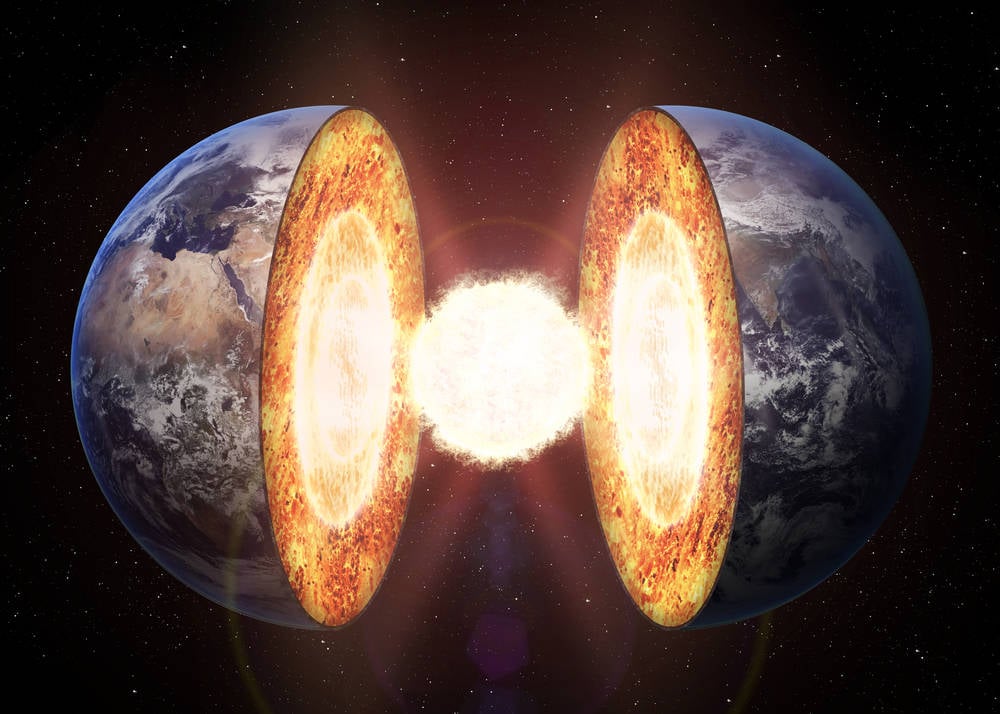The remains of a giant ancient space rock that scientists believe collided with Earth billions of years may be hiding deep below Earth’s surface, according to a research paper published in Nature on Wednesday.
A team of geophysicists and astronomers, led by the California Institute of Technology (Caltech), point to two “continent-sized anomalies” blobs of dense material discovered in the 1980s in Earth’s lowermost mantle, the layer between the crust and the outer core – as evidence that an object named Theia smashed into our home planet in the deep past. The collision with Theia is thought to have ejected the material that eventually formed the Moon.
It may also have left artefacts within Earth, called “large low-velocity provinces” (LLVPs) that geoboffins found by recording seismic waves patterns travelling through our planet’s interior. The speed of the seismic waves change when they move through materials of different densities and the patterns measured through the LLVPs suggested that the large structures were dense and may contain high levels of iron.
Qian Yuan, first author of the study, and a postdoctoral scholar in geophysics at Caltech, said he attended a seminar given by Mikhail Zolotov, a professor at Arizona State University, who described the theory that the Moon formed after Theia hit Earth.
“Right after Mikhail had said that no one knows where the impactor is now, I had a ‘eureka moment’ and realized that the iron-rich impactor could have transformed into mantle blobs,” he said in a statement. To test this idea, the researchers developed physical models simulating the aftermath of the proposed event and found that it was possible that fragments of Theia may have been absorbed by Earth and ejected to create the Moon.
“Our canonical giant-impact simulations show that a fraction of Theia’s mantle could have been delivered to proto-Earth’s solid lower mantle. We find that [Theia’s mantle material (TMM)] is intrinsically 2 to 3.5 percent denser than proto-Earth’s mantle based on models of Theia’s mantle and the observed higher [iron oxide] content of the Moon,” he notes.
“Our mantle convection models show that dense TMM blobs with a size of tens of kilometres after the impact can later sink and accumulate into LLVP-like thermochemical piles atop Earth’s core and survive to the present day. The LLVPs may, thus, be a natural consequence of the Moon-forming giant impact,” according to the paper’s abstract.
In other words, the impact pushed material leftover from Theia into Earth’s upper mantle where it stayed intact before gradually sinking to the lower mantle. Those sunken remains are the two large, dense anomalies detected decades ago.
The team believes that if Earth’s lower mantle was hotter, the leftover remnants of Theia would have mixed with our planet’s interior material. Now, they want to study how the LLVPs may have influenced Earth’s geological evolution.
“A logical consequence of the idea that the LLVPs are remnants of Theia is that they are very ancient,” Paul Asimow, co-author of the paper, a professor of geology and geochemistry at Caltech, said.
“It makes sense, therefore, to investigate next what consequences they had for Earth’s earliest evolution, such as the onset of subduction before conditions were suitable for modern-style plate tectonics, the formation of the first continents, and the origin of the very oldest surviving terrestrial minerals.”
The Register has asked Caltech for comment. ®

Dr. Thomas Hughes is a UK-based scientist and science communicator who makes complex topics accessible to readers. His articles explore breakthroughs in various scientific disciplines, from space exploration to cutting-edge research.








